How to Teach Kids to Navigate Embarrassment in Social Settings
What’s inside this article: A look at what embarrassment is, why it happens, and five ways to help children cope with embarrassment effectively and teaching strategies. Includes printable worksheets to help kids learn to navigate embarrassing moments.
We’ve all been there—those moments when we feel our cheeks turn rosy, our hearts race, and we wish we could disappear into thin air. Yes, we’re talking about embarrassment. It’s a common emotion that everyone struggles with from time to time.
For children, navigating embarrassment in social settings can be particularly challenging. As parents and teachers, we can educate kids to ensure they have the necessary social skills to handle these situations more confidently.
Understanding Embarrassment
Embarrassment is a natural emotional response that arises when we find ourselves in situations that threaten our self-image or violate social norms. It often occurs when we feel self-conscious or judged by others.
It’s important for kids to know that embarrassment is a universal experience, and everyone goes through it at some point. Knowing this can help children understand that they are not alone in their feelings.
If your child has ADHD, they may be dealing with rejection-sensitive dysphoria and experience embarrassment more often and more intensely than their peers.
Common Embarrassing Moments for Kids:
There are several awkward events that children seem almost universally to find embarrassing, and most kids experience at least one, if not multiple, of these events at one point on another:
- Tripping in public
- Forgetting lines in a play
- Food spills on clothes
- Accidentally calling teacher “mom”
- Passing gas
- Clothing malfunctions
- Being caught picking nose
- Stomach growling during a quiet moment
- Mispronouncing words
- Falling off a bike
- Blurting out something the wrong answer
- Getting a wedgie
- Singing off-key in a talent show
- Falling off playground equipment
- Someone pointing out that their pants zipper is down
- Accidentally walking into the wrong bathroom
- Dropping a tray in the cafeteria
- Getting caught with toilet paper stuck to their shoe
- Spilling a drink
- Tucking shirt into underwear
- Slipping on a wet floor
- Snorting while laughing
- Getting caught with a funny facial expression in a group photo.
Embarrassment Coping Strategies for Kids
Kids who are resilient and have positive self-esteem overcome embarrassing moments more quickly. So, many coping strategies for embarrassment involve building the necessary confidence and resilience while minimizing the shame that kids may feel for making mistakes.
Use Positive Affirmations:
Encourage children to embrace positive self-talk to counteract negative thoughts and build confidence. Teach them to replace self-critical statements like, “I’m so stupid,” with uplifting affirmations such as, “I am resilient and capable.”
By empowering children with positive affirmations, they can reframe embarrassing moments and boost their self-esteem.
Example: Imagine your child accidentally spills their drink at a friend’s house. Instead of feeling mortified, they can use the affirmation, “Mistakes happen, and I can handle this. It’s just a small spill!”
Foster Open Communication
Create a safe and non-judgmental space for children to express their feelings about embarrassing situations. Encourage them to talk about their experiences openly, whether it’s a blunder in class or a clumsy mishap during a sports game.
Parents and teachers can help children process their emotions and gain perspective by listening attentively and providing support.
You can also share some of your own embarrassing moments with them. Opening up about your experiences shows children they aren’t alone, these things happen to everyone, and allows them to see you’re a safe person to talk to when you feel this way.
Example: Picture your child recounting a time when they tripped in front of their crush. Listen empathetically, offer reassurance, and remind them that everyone trips sometimes—tell them about a time something similar happened to you.
Reframe Embarrassing Moments
Teach children the art of reframing by helping them view embarrassing situations from a different perspective. Encourage them to focus on the lessons learned or the humor of the situation. But don’t dismiss or minimize the discomfort they may be feeling presently. Validating emotions is essential.
By reframing their experiences, children can transform embarrassment into valuable opportunities for growth and resilience.
Example: Suppose your child mispronounces a word during a school presentation. Help them see it as a chance to learn from their mistake and remind them that everyone, even famous actors and speakers, stumble over their lines sometimes.
Encourage Problem-Solving
Equip children with problem-solving skills to handle embarrassing moments effectively. Teach them to evaluate their options and choose a course of action that aligns with their values and feelings.
By empowering children to take control of the situation, they can regain their confidence and easily navigate embarrassment.
Example: If your child accidentally blurts out an inappropriate comment in class or during a conversation, encourage them to apologize sincerely and learn from the experience, making a mental note to think before speaking next time.
Practice Assertiveness
Helping children develop assertiveness means they’re better able to express themselves confidently and navigate social situations assertively.
Teaching kids to be assertive helps them communicate their boundaries respectfully, say “no” when necessary, and effectively communicate their thoughts and feelings.
Assertiveness can empower children to handle embarrassment because they’ll have better control over their reactions and the ability to advocate for themselves when needed.
Example: Imagine your child is invited to a party where they don’t know many people. Encourage them to approach someone new and start a conversation by saying something like, “Hi, I’m [name]. I’m new here, and it’s great to meet you!”
Remind them that making new connections can be exciting and nerve-wracking, but everyone appreciates a friendly introduction, even if it doesn’t grow into a friendship.
Assertive Vs Aggressive Communication SkillsTeaching these Concepts to Children:
Now that we’ve explored five healthy ways to help children cope with embarrassment let’s discuss how adults can effectively teach these concepts.
- Lead by Example: Children learn by observing the adults in their lives—model positive behaviors, such as handling embarrassing situations with humor and resilience. Share your own stories of embarrassing moments and how you overcame them. By demonstrating healthy coping strategies, you inspire children to adopt them, too.
- Encourage Reflection: After a child experiences embarrassment, encourage them to reflect on the situation. Ask open-ended questions like, “How did you feel during that moment?” and “What do you think you could have done differently?” By engaging them in thoughtful discussions, you help them develop self-awareness and critical thinking skills.
- Role-play Scenarios: Engage children in role-playing activities to practice assertiveness and problem-solving. Create hypothetical embarrassing scenarios and encourage them to respond confidently. This hands-on approach allows children to build the skills they need in a safe and supportive environment.
- Direct Instruction: Directly teach children how to cope with embarrassment using worksheets, books, games, activities, and lesson plans that cover the topic in detail.
- Provide Reassurance and Support: Let children know that it’s natural to feel embarrassed and that everyone experiences it at some point. Reassure them that you are there to support and guide them through these moments. This reassurance creates a sense of safety and trust, enabling children to open up about their experiences and seek guidance when needed. Try reassuring and validating their feelings using emotion coaching, explained here.
Coping With Embarrassment Printables:
This nine-page printable bundle teaches children about feeling embarrassed and how to cope with embarrassment.
It includes a social script explaining what embarrassment is, coping skills, a positive affirmation activity, discussion questions, and questions about embarrassing moments.
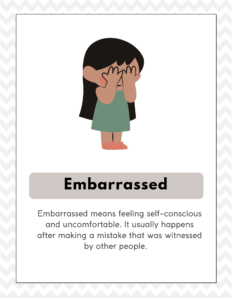
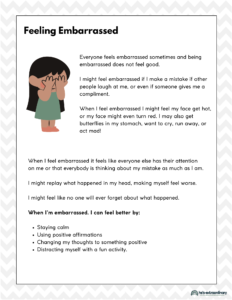
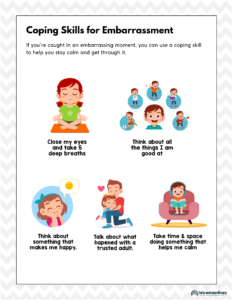

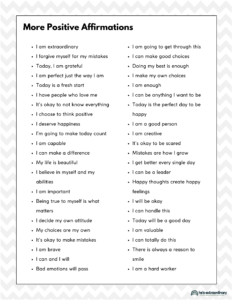
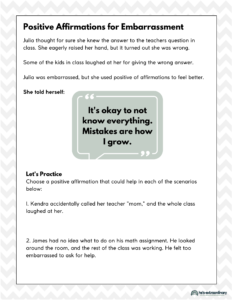
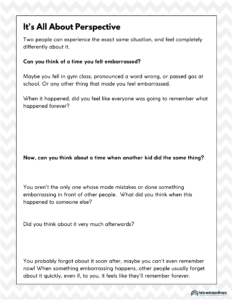
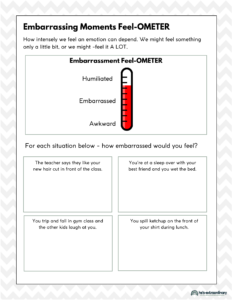
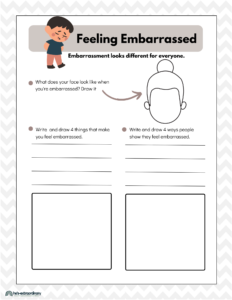
You can download these printables here:
Coping With EmbarrassmentWhy It’s Important:
Developing strong social skills and the ability to navigate embarrassment effectively is crucial for children’s overall well-being.
These skills empower children to communicate effectively, build healthy relationships, and develop resilience when facing adversity. By equipping children with these tools, we set them on a path to confidently navigate social settings and embrace their authentic selves.
Helping children navigate embarrassment in social settings is a valuable gift we can offer as parents and teachers. By teaching effective communication, promoting assertiveness, and developing problem-solving skills, we empower children to handle embarrassing moments with grace and confidence.

